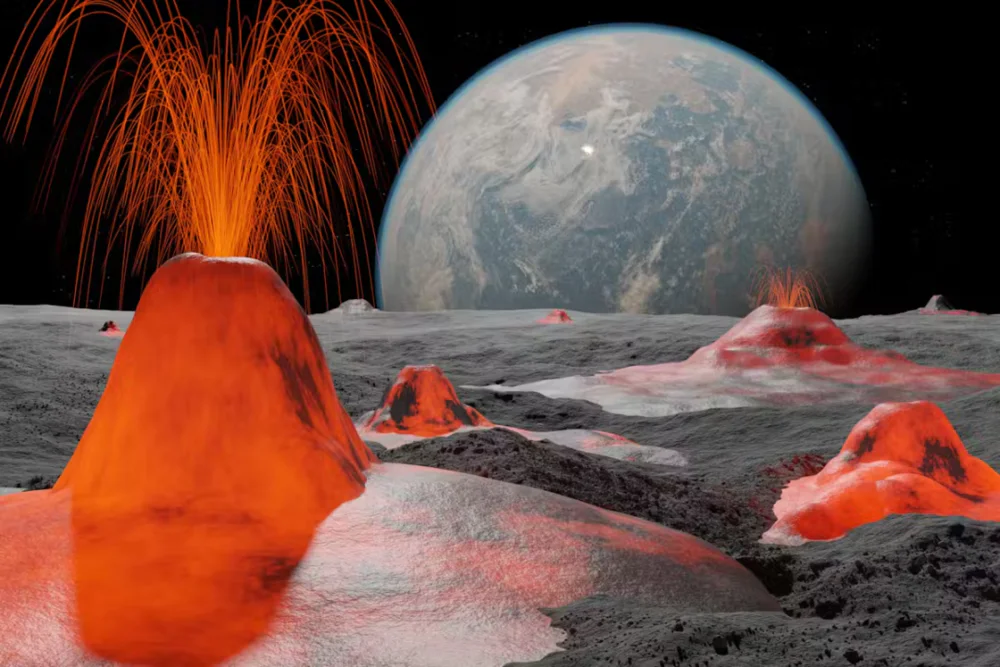The traditional view holds that the Moon formed approximately 4.35 to 4.51 billion years ago. However, a recent study published in Nature presents a new perspective. Three scientists from different fields, each approaching the topic from their own professional viewpoint, have revisited the timing of the Moon's formation.
Their analysis suggests that the Moon's true age might be older than previously thought. This discovery offers a fresh perspective on the Moon's origin and evolution, potentially altering our understanding of its early history.
How did the Moon form?
In the late 1980s, at a scientific conference held in Hawaii, scientists proposed a widely accepted theory explaining the origin of the Moon. This theory, known as the "giant impact hypothesis," suggests that a Mars-sized body (Theia) collided violently with the early Earth, and the immense impact force threw molten material into space. These hot, glowing materials gradually accumulated and eventually formed the Moon we see today.
This hypothesis not only vividly describes the Moon's origin but also explains some of its unique characteristics. For example, because the Moon began in a high-temperature molten state, it contains very little volatile material (such as water). Additionally, the Moon's iron core is very small, as it was primarily formed from the Earth's outer layers, which contain low amounts of iron. The Moon's surface is also covered by a white lunar crust made of minerals that floated to the surface as the molten Moon gradually solidified.
Initially, the glowing, newly formed Moon was very close to Earth—about the same distance at which television satellites orbit Earth today. The early Earth itself was largely molten and rotating rapidly, and the early Moon caused huge tidal effects on Earth.

These tides drew energy from Earth's rotation, transferring it to the Moon's orbit, causing the Moon to slowly drift away from Earth while also slowing Earth's rotation. This process continues today—the Moon is still moving away from Earth at about 5 centimeters per year.
When did the Moon form?
Determining the exact time of the Moon's formation and when it began to move away from Earth has always been a complex question.
Scientists have tried to determine the Moon's age by analyzing rock samples collected from the Moon. The oldest Moon rocks are about 4.35 billion years old, which is roughly 200 million years after the formation of the solar system. Many geochemists believe that the age of these rocks should directly reflect the Moon's formation time.
However, not all scientists agree with this view. For example, some planetary formation models suggest that within the first 200 million years after the solar system's formation, planets had already cleared most of the material around the Sun. In such a time frame, a late, massive impact—like the one indicated by the rock samples—seems unlikely.
The new perspective
This is where the new study comes in. The researchers followed up on a 2016 study of the Moon that suggested the Moon might have undergone extreme heating events as it gradually moved away from Earth.
This heating process is very similar to the mechanism that heats Io, one of Jupiter's moons. Under Jupiter's powerful tidal forces, Io is compressed and stretched, causing internal heating and intense volcanic activity, making it one of the most volcanically active bodies in the solar system. Similarly, the Moon might have experienced a similar internal heating process due to Earth's tidal forces. Just as a rubber ball heats up when repeatedly squeezed, this tidal heating could have caused significant internal heating of the Moon's rocks.
All rocks contain tiny "internal clocks"—their age can be measured through the decay of radioactive elements. However, if the Moon experienced sufficiently strong tidal heating events, these "clocks" might have been reset, and time would only begin to be recorded again once the rocks cooled.
Therefore, the Moon rocks dated to 4.35 billion years old might only reflect the time when the Moon underwent tidal heating events, not its actual formation time. This suggests the Moon's birth occurred much earlier!
The Moon began as molten and then cooled, and after about 100 million years, it was reheated. This heating event might have reset the "clocks" recorded by the Moon rocks.
The new formation time aligns with planetary formation theories and can also explain the later ages suggested by the rock records. This age difference can be explained by tidal heating, which reset the rock clocks, making them record a later age than the actual formation time.
Future directions of exploration
As is often the case in science, two research teams have proposed similar yet distinct views. The study published in Nature argues that the tidal heating events occurred when the Moon was farther from Earth, while a research team from Arizona State University suggests these events took place when the Moon was closer to Earth.
To determine which hypothesis is correct, or to possibly overturn both, more time and research are needed. Verifying these hypotheses requires more Moon samples. Fortunately, China's Chang'e-6 mission successfully returned samples from the Moon's far side in June 2024. If the age of these samples still shows about 4.35 billion years, it will support the study's conclusions; if the age is greater, new theories may need to be proposed.
In Earth and planetary science, geochemists and geophysicists often propose radically different, even contradictory hypotheses, partly due to their use of different measurement methods and scientific languages. Overcoming this language barrier is very challenging. This new study demonstrates how bridging gaps between languages and disciplines can benefit scientists from various fields.
References:







